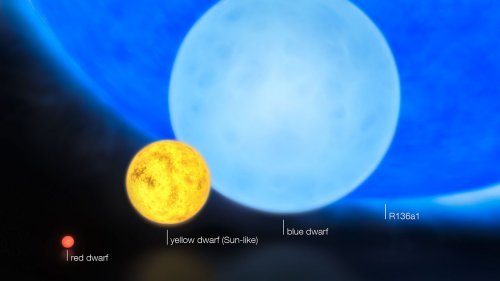
By Hamish Johnston
Scientists – and particularly astronomers – are always discovering things that are bigger, faster or farther than before.
This often makes for a good story – but is it news?
A case in point is the biggest star ever that has been found by a team of astronomers using several European Southern Observatory (ESO) telescopes. (The star was actually discovered some time ago, but getting an accurate mass was no mean feat).
It’s called R136a1 and is twice as massive as the previous contender. This doesn’t sound that impressive until you realize that it’s a whopping 300 times more massive than the Sun. You can see it compared to the Sun in the above artist’s impression from the ESO.
That’s big, but the universe is a humungous place full of very big things just waiting to be discovered. And next week or next month or next year someone is bound to find an even bigger star.
When we discussed the possibility of covering this discovery at our last news meeting we decided that biggest wasn’t enough – there had to be some scientific significance.
The obvious question to ask is “does this discovery improve our understanding of star formation and evolution?”
I suspect the answer is “it tells us that conventional models of star formation – most of which put an upper limit on star size of about 20 solar masses – are even more deficient than previously thought”.
This is, of course, very important to folks trying to improve models of star formation but I don’t think it merits a news story – particularly because astronomers have known for some time that their models can’t cope with huge stars.
BBC Radio 4 did deem the discovery newsworthy and interviewed lead astronomer Paul Crowther of the University of Sheffield on this morning’s Today programme. You can listen to the interview here.
Crowther explains that the finding is significant because it suggests the existence of a third class of stars that end their lives in extremely bright supernova explosions – but unlike their lighter counterparts, leave behind no black holes or neutron stars.
And that’s an interesting story in itself!



